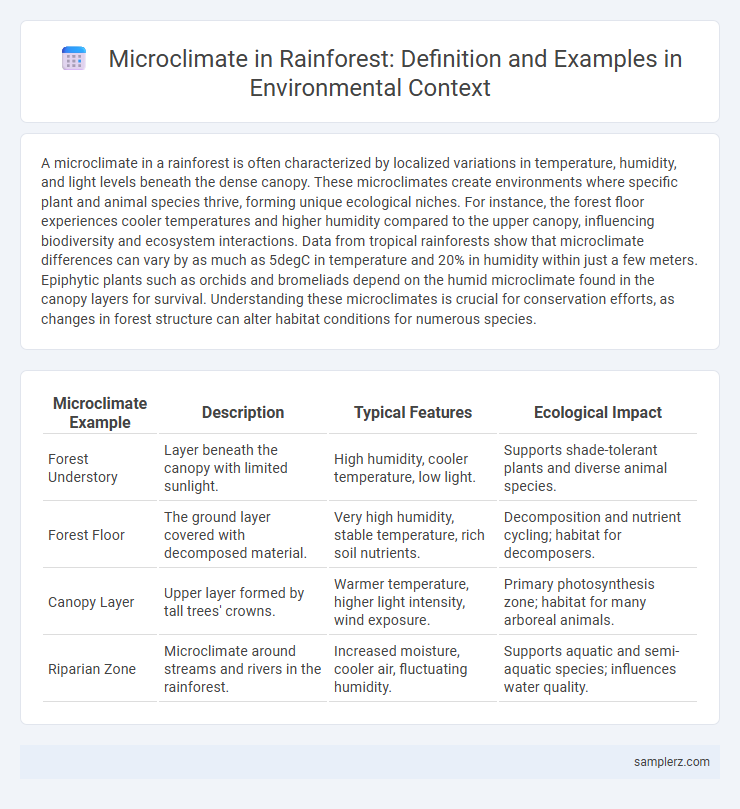A microclimate in a rainforest is often characterized by localized variations in temperature, humidity, and light levels beneath the dense canopy. These microclimates create environments where specific plant and animal species thrive, forming unique ecological niches. For instance, the forest floor experiences cooler temperatures and higher humidity compared to the upper canopy, influencing biodiversity and ecosystem interactions. Data from tropical rainforests show that microclimate differences can vary by as much as 5degC in temperature and 20% in humidity within just a few meters. Epiphytic plants such as orchids and bromeliads depend on the humid microclimate found in the canopy layers for survival. Understanding these microclimates is crucial for conservation efforts, as changes in forest structure can alter habitat conditions for numerous species.
Table of Comparison
| Microclimate Example | Description | Typical Features | Ecological Impact |
|---|---|---|---|
| Forest Understory | Layer beneath the canopy with limited sunlight. | High humidity, cooler temperature, low light. | Supports shade-tolerant plants and diverse animal species. |
| Forest Floor | The ground layer covered with decomposed material. | Very high humidity, stable temperature, rich soil nutrients. | Decomposition and nutrient cycling; habitat for decomposers. |
| Canopy Layer | Upper layer formed by tall trees' crowns. | Warmer temperature, higher light intensity, wind exposure. | Primary photosynthesis zone; habitat for many arboreal animals. |
| Riparian Zone | Microclimate around streams and rivers in the rainforest. | Increased moisture, cooler air, fluctuating humidity. | Supports aquatic and semi-aquatic species; influences water quality. |
Introduction to Rainforest Microclimates
Rainforest microclimates exhibit unique temperature and humidity patterns influenced by dense vegetation, canopy layers, and constant rainfall. These microclimates create distinct ecological niches, supporting diverse flora and fauna adapted to stable, moist conditions. Understanding rainforest microclimates reveals how localized climate variations contribute to biodiversity and ecosystem resilience.
Canopy Layer: Temperature and Humidity Patterns
The canopy layer of a rainforest exhibits unique microclimate characteristics, with temperatures typically ranging between 25 to 30 degrees Celsius and relative humidity levels often exceeding 90%. This microenvironment creates a stable thermal refuge that supports diverse flora and fauna adapted to consistent warmth and moisture. The dense foliage reduces direct sunlight penetration, maintaining cooler and more humid conditions compared to the forest floor.
Understory Microclimate Characteristics
The understory microclimate in rainforests is characterized by lower light levels, higher humidity, and more stable temperatures compared to the canopy layer, creating a unique environment for shade-tolerant plants and diverse animal species. Reduced solar radiation and dense vegetation ensure minimal temperature fluctuations, while the high humidity supports moisture-dependent organisms and influences nutrient cycling. These microclimate conditions contribute to the rich biodiversity and ecological resilience of tropical rainforest understories.
Ground Layer: Soil Moisture and Temperature Variations
The ground layer in a rainforest exhibits distinct microclimate characteristics, primarily influenced by soil moisture and temperature variations. High humidity levels and dense canopy cover create cooler, stable temperatures in the soil, which can vary significantly within short distances due to organic matter decomposition and root absorption. These microclimate conditions support diverse microorganisms and nutrient cycling crucial for rainforest biodiversity and ecosystem function.
Effect of Water Bodies on Local Rainforest Climate
Water bodies within rainforests, such as rivers and lakes, significantly influence local microclimates by regulating temperature and humidity levels. These water sources enhance evapotranspiration, increasing atmospheric moisture that promotes consistent rainfall and sustains the dense vegetation. This interaction creates cooler, more stable microclimatic conditions essential for rainforest biodiversity and ecosystem health.
Microclimates Around Treefall Gaps
Microclimates around treefall gaps in rainforests exhibit distinct variations in temperature, humidity, and light compared to the surrounding canopy. These gaps allow increased sunlight to penetrate, raising local temperatures and promoting faster evaporation, which reduces humidity levels. The altered microenvironment supports unique plant species and accelerates regeneration processes, influencing biodiversity and ecosystem dynamics.
Epiphytic Plant Zones and Their Unique Conditions
Epiphytic plant zones in rainforests create unique microclimates characterized by increased humidity and reduced temperature fluctuations compared to the forest floor. These zones support diverse epiphyte species such as orchids and bromeliads, which thrive on tree branches without soil, relying on moisture from the air and organic debris. The interplay of light filtration, air circulation, and moisture retention within epiphytic layers contributes to their specialized ecosystems and biodiversity hotspots.
Microclimate of Rainforest Edge Habitats
Rainforest edge habitats exhibit a distinct microclimate characterized by increased sunlight exposure, higher temperature fluctuations, and reduced humidity compared to the dense forest interior. These conditions influence plant species composition, favoring sun-tolerant and drought-resistant vegetation. Edge microclimates also affect animal behavior, impacting species that depend on stable, moist environments for survival.
Influence of Elevation on Rainforest Microclimates
Elevation significantly impacts rainforest microclimates by altering temperature, humidity, and precipitation patterns within short vertical distances. Higher elevations experience cooler temperatures and increased cloud cover, which reduce solar radiation and create distinct moisture conditions compared to lowland areas. These microclimatic variations influence biodiversity distribution, species adaptation, and ecosystem processes in mountainous rainforest regions.
Human Impact on Rainforest Microclimate Diversity
Human activities such as deforestation and land conversion significantly alter the microclimate diversity within rainforests by disrupting canopy structure, which changes light penetration, temperature, and humidity levels. Selective logging and clear-cutting lead to increased soil exposure, raising ground temperatures and reducing moisture retention, thus affecting local biodiversity. These microclimate shifts directly influence the survival of sensitive species and the overall ecological balance in rainforest ecosystems.

example of microclimate in rainforest Infographic
 samplerz.com
samplerz.com